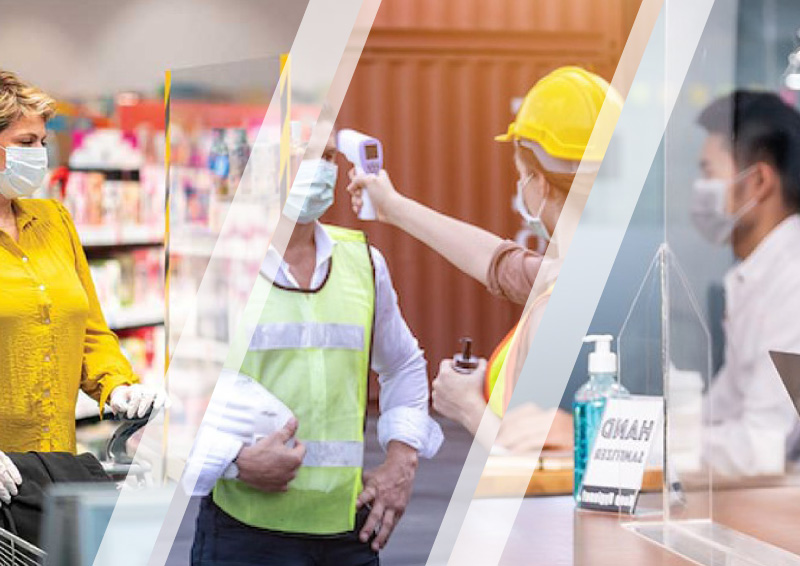Risk assessment is a key tool in managing the spread of Covid-19 in the workplace. Pat Perry, author of Risk Assessments Questions and Answers: A practical approach, Second edition, sums up steps that need to be taken.

- Updated: 13 Jan 2021
- Author: Pat Perry, CMIOSH
Employers, and those who are self-employed working with or near other people, must consider the risk of Covid-19 transmission and infection in the workplace. It is a workplace hazard, unfortunately.
Construction sites especially have been identified as a working environment where the risk of Covid-19 spread can be high. This is because of the transient nature of some operatives, and the likelihood that social distancing will not be followed as trades often work in confined spaces.
An employer must protect people from harm. This includes taking reasonable steps to look after the workers and others from coronavirus spread in the workplace.
The first step is to carry out a risk assessment.
You must:
- identify what work activity or situations might cause transmission of the virus
- think about who could be at risk
- decide how likely it is that someone could be exposed
- act to remove the activity or situation, or if this isn’t possible, control the risk
- inform your employees and others of the steps you are taking to manage the risk.
Construction companies acting as principal contractors on building projects are responsible for managing the risk of coronavirus spread on the site.
Once you have completed the risk assessment you may be able to declare your construction site and/or work premises “Covid secure” so that employees and others can be assured that their safety has been considered. All premises must be able to demonstrate that they are “Covid secure” and both HSE and local authority officers are inspecting businesses to ensure that they are compliant.
HSE have identified the following key contraventions occurring on construction sites during these inspections:
- management and operatives not following social distancing guidelines
- inadequate welfare facilities on site with insufficient cleaning regimes
- too many people in the canteen area with insufficient segregation
- not enough hand sanitising stations on site and no emphasis on hand washing
- PPE not available when required
- inadequate Site Operating Procedures found on site
- inadequate Covid-19 Risk assessments.
Employers will need to consider groups who may be at higher risk of infection and/or poorer outcomes if infected with Covid-19. The Public Health England report identifies disparities in the risk and outcomes of Covid-19 recognising higher-risk groups, including those who:
- are older males
- have a high body mass index (BMI)
- have health conditions such as diabetes
- are from some Black, Asian or minority ethnicity (BAME) backgrounds.
The risk assessment approach for Covid-19 is no different to that of any risk assessment process i.e. identify the hazards, establish the likelihood of harm and decide the control measures necessary to eliminate or reduce the risks of harm.
My book Risk Assessments: Questions and Answers, Second edition, available in print and as an eBook, guides you through the process and provides a number of tools to help prepare the paperwork.
Clients commissioning building projects may want to see the site Covid-19 risk assessment before works commence, so that they can satisfy themselves that appropriate control measures and management plans are in place as required under the Construction (Design and Management) Regulations 2015. Clients have a duty to ensure that reasonable steps have been taken to ensure that arrangements are in place, or made, for managing a project, including the allocation of sufficient time and resources, and that they are suitable to ensure that the construction work can be carried out so far as is reasonably practicable without risk to the health and safety of any persons.
The Client must take reasonable steps to ensure that the arrangements made are maintained and reviewed throughout the project.
Where premises are open to the public, for example sales offices, show homes, and hospitality venues, customers may need to see the written risk assessment before they are confident to attend the venue.
Information on Covid-19 is changing frequently as the experts develop their knowledge about how it is spread, the health effects that infection may cause, and vaccines become available.
Risk assessments for Covid-19 must be continuously reviewed and updated to ensure they comply with Government advice and guidelines. As areas of the country move into different tier levels of lockdown, employers will need to review their risk assessment and make changes where necessary.
Employers must not forget to consider the mental health wellbeing of employees and the risk of increased stress because many employees will be concerned about their health and safety. They may also be subjected to higher levels of customer abuse, both verbal and physical, due to the very challenging circumstance we all find ourselves in.
So, please do not be daunted by the need to prepare a Covid-19 risk assessment. Follow the tried and tested procedures for completing risk assessments as outlined in the Risk Assessments: Questions and Answers.
Communicate with your employees and others, and provide re-assurance that, as an employer, you have put in place the necessary measures to minimise the spread of the virus in your business.
Interested in finding out more about best practice solutions for risk assessments? Why not to check out Risk Assessments: Questions and answers, Second edition, available in print and as an eBook.
